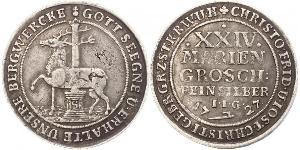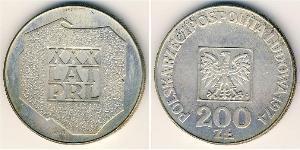(sold for $60.0)
1792, Brunswick-Luneburg-Calenberg-Hannover. Silver 24 Mariengroschen (2/3 Thaler) Coin. He was both Duke Elector of Hanover and King of England!
Mint Year: 1792 Mint Place: Clausthal Reference: KM-341. Condition: A well-circulated VF+ Mint Master: Philipp Ludwig Magius (P.L.M.) Denomination: 24 Mariengroschen (Gulden = 2/3 Thaler) Weight: 13.09gm Diameter: 33mm Material: Silver
Obverse: Crowned shield with coat-of-arms of the House of Hannover & Great Britain. Fractional thaler value (2/3) below shield. Legend: GEORGIUS . III . D . G . BRITANNIARUM . REX . F . D . / N.D. REICHS.F. - FEIN SILBER Reverse: Large value numeral (24) above denomination (MARIEN GROSCH:), date (1792) and mint master´s initials (P.L.M.). Legend: * RUNS . & . LUN . DUX . S . R . I . A . TH . & . ELECT .
The House of Hanover (the Hanoverians) is a Germanic royal dynasty which has ruled the Duchy of Brunswick-Lüneburg (German: Braunschweig-Lüneburg), the Kingdom of Hanover and the Kingdom of Great Britain and the Kingdom of Ireland. It succeeded the House of Stuart as monarchs of Great Britain and Ireland in 1714 and held that office until the death of Victoria in 1901. They are sometimes referred to as the House of Brunswick and Lüneburg, Hanover line. The House of Hanover is a younger branch of the House of Welf, which in turn is the senior branch of the House of Este, with all three being offshoots of the ancient Saxon House of Wettin.
Queen Victoria was the granddaughter of George III, and was a descendant of most major European royal houses. She arranged marriages for her children and grandchildren across the continent, tying Europe together; this earned her the nickname "the grandmother of Europe." She was the last British monarch of the House of Hanover; her son King Edward VII belonged to the House of Saxe-Coburg and Gotha since she could not inherit the German kingdom and duchies under Salic law. Those possessions passed to the next eligible male heir, her uncle Ernest Augustus I of Hanover, the Duke of Cumberland and Teviotdale—the fifth son of George III. In the United Kingdom, after World War I, King George V changed the house's name from Saxe-Coburg and Gotha to the currently serving House of Windsor in 1917. Both dynastic names are offshoots of the 800-plus years old House of Wettin.
George III (George William Frederick; 4 June 1738 – 29 January 1820) was King of Great Britain and King of Ireland from 25 October 1760 until the union of these two countries on 1 January 1801, after which he was King of the United Kingdom of Great Britain and Ireland until his death. He was concurrently Duke and prince-elector of Brunswick-Lüneburg ("Hanover") in the Holy Roman Empire until his promotion to King of Hanover on 12 October 1814. He was the third British monarch of the House of Hanover, but unlike his two Hanoverian predecessors he was born in Britain, spoke English as his first language, and never visited Hanover.
His life and reign, which were longer than those of any previous British monarch, were marked by a series of military conflicts involving his kingdoms, much of the rest of Europe, and places farther afield in Africa, the Americas and Asia. Early in his reign, Great Britain defeated France in the Seven Years' War, becoming the dominant European power in North America and India. However, many of its American colonies were soon lost in the American War of Independence. Further wars against revolutionary and Napoleonic France from 1793 concluded in the defeat of Napoleon at the Battle of Waterloo in 1815.
In the later part of his life, George III suffered from recurrent, and eventually permanent, mental illness. Medical practitioners were baffled by this at the time, although it has since been suggested that he suffered from the blood disease porphyria. After a final relapse in 1810, a regency was established, and George III's eldest son, George, Prince of Wales, ruled as Prince Regent. On George III's death, the Prince Regent succeeded his father as George IV.
Historical analysis of George III's life has gone through a "kaleidoscope of changing views" that have depended heavily on the prejudices of his biographers and the sources available to them. Until re-assessment in the later half of the twentieth century, his reputation in America was one of a tyrant and in Britain he became "the scapegoat for the failure of imperialism". He is often remembered as "The Mad King" and "The King Who Lost America".

|
Posted by:
anonymous 2018-05-22 |
5 Cent Canada Silver Edward VII (1841-1910)
group has 11 coins / 9 prices
⇑























